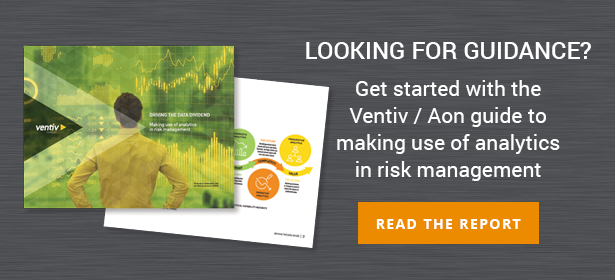In a recent article for Insurance Day, Ventiv Managing Director Steve Cloutman talked about the reasons why, despite the massive advantages associated with digitizing risk management processes, leaders are concerned about the perceived risks associated with such a transformation.
We’re currently experiencing what many call the Fourth Industrial revolution and market commentators predict that artificial intelligence (AI) will bring automation into the wider workforce, including risk management.
At the same time, we’re seeing another, related transformation taking place across organisations of all kinds: digitization. For the purposes of this article, digitization refers to the process of purposefully moving from manual or analogue processes, such as managing commercial-insurance renewal data using email and spreadsheets, to digitized and, where possible, automated processes without any in-kind changes to the processes themselves.
However, research by the U.K.’s Chartered Institute of Internal Auditors suggests that risk and insurance leaders are conflicted about digitization, suggesting that:
“The cost and efficiency benefits of automation and other digital processes can be transformative, if harnessed to their full potential. But organisations must also consider the risks associated with such transformation.”
This thinking can be summarized as such: Do the risks that come with digitization outweigh the potential upsides? Or, do the benefits of digitization outweigh the risks?
It’s clear that with much talk of the different benefits and risks associated with the adoption of digitization, the practice of risk and insurance management has reached a crossroads on the subject.
But what if we try to move beyond a risk-versus-benefit framing? The rapid and widespread growth of digitization across industries suggests that digitization is a foregone conclusion, and businesses will need to embrace it to thrive. We suggest instead focusing on what is possible, and why.
According to an observation by McKinsey &. Co., “Successful companies focus not on a digital strategy but a strategy for the digital age.” We believe that it’s smart to digitize now, wherever it’s possible and will deliver value.
This is the approach we take with our own clients, such as Cox Enterprises, applying that philosophy to the level of the corporate function.
Cox Enterprises is a $20 billion global communications, automotive services, and media company based in Atlanta, Georgia, U.S.A. We worked with the company’s risk and insurance team to deploy a digital, mobile-enabled data-intake tool for the specific purpose of improving the efficiency and accuracy of its exposure-value collection. In keeping with McKinsey’s advice, it was a focused use case, but it’s been successful and has empowered the team to digitize additional functions, such as incident intake at its automobile auctions.
Advanced analytics is another area of digitization that delivers strong value to risk and insurance teams. Today’s analytics solutions go far beyond dashboards and other forms of reporting.
Our clients increasingly come to us to understand how they can broaden their data sets and incorporate more third-party data into their analytics applications. There is a wealth of this data available from connected devices, the “Internet of Things” and from government agencies, weather, census bureaus and anonymized benchmarking data from consultancy firms. All this information can help risk managers more accurately predict and manage their risks.
We’ve also observed a shift towards preventing risk rather than insuring against it. Preventing losses can lead to big savings on risk transfer, but to achieve this, managers need access to the kind of analytics that provide real actionable insights into how to prevent losses.
AI provides the starting point for making huge amounts of data accessible, allowing users to examine this information in detail—for example by enabling them to interrogate the data using simple questions, as if they were searching in Google or talking to Alexa or Siri. AI then empowers effective visualization of the results in any number of charts and graphs, making interpreting the results and patterns easy.
The Internet of Things is incredibly useful for generating a lot of information, but for risk managers to harness this information to improve their efficiencies, they need to learn how to use that information. This is where AI comes in, helping risk managers to assemble and compare vast amounts of data easily
We predict that in the near future, risk and insurance professionals will become a lot more involved with innovation and strategic business planning and that’s where they need to innovate.
We don't believe technology will eliminate the basic principles of risk management; although the mechanisms are new, they're also the same. Process-orientated digitization will only improve what risk managers have always done, and as for AI, we don't see it as coming close to replacing the role of the risk manager, at least in the shirt term, maybe ever.
Risk managers must evolve to be comfortable with using these advanced risk analytics software and risk reporting tools, and they should know when to rely on them and when to prioritize their own decision making skills and experience.
Original article appeared in Insurance Day on 24th June 2019.
Steve Cloutman is the Managing Director here at Ventiv Technology. If you would like any further information on the topics discussed here please contact him at STEVE.CLOUTMAN@VENTIVTECH.COM















